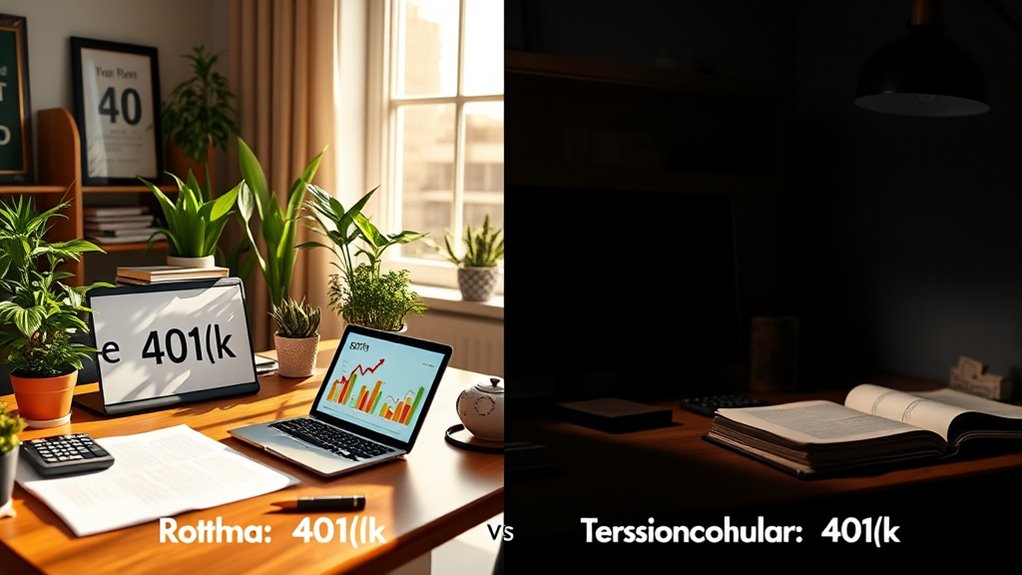When choosing between a Roth and a traditional 401(k), think about your current and future tax situation. If you expect higher taxes in retirement, a Roth might be a better fit for tax-free withdrawals. On the other hand, if immediate tax relief is a priority, consider a traditional 401(k). Don’t forget about catch-up contributions if you’re over 50, as they can boost your savings markedly. Explore how to optimize your contributions for maximum benefit.
Key Takeaways
- Assess your current and expected future tax brackets to choose between Roth and traditional contributions for optimal tax advantages.
- Utilize catch-up contributions if aged 50+, and super catch-up for ages 60-63, to enhance retirement savings significantly.
- Consider cash flow needs: traditional contributions lower immediate taxable income, while Roth contributions may reduce take-home pay upfront.
- Employer matching contributions are always pre-tax; your choice between Roth or traditional does not impact these contributions.
- Diversifying contributions between Roth and traditional accounts can provide a balanced tax strategy for retirement planning.
Understanding Contribution Limits

When it comes to understanding contribution limits for 401(k) accounts, knowing the specifics can considerably impact your retirement savings strategy. For 2025, you can contribute up to $23,500 to both Roth and traditional 401(k) accounts. If you’re 50 or older, you can add an extra $7,500 as a catch-up contribution. Those aged 60 to 63 have an even greater opportunity, thanks to SECURE Act 2.0 provisions, allowing a super catch-up contribution of up to $11,250. Unlike Roth IRAs, Roth 401(k)s don’t impose income limits on contributions, making them an attractive option. Understanding these limits helps you maximize your contributions and aligns your retirement goals with your financial situation. Additionally, alternative assets like gold have gained popularity among retirees as a way to diversify portfolios and hedge against inflation.
The Power of Catch-up Contributions

How can catch-up contributions supercharge your retirement savings? If you’re aged 50 or older, you can take advantage of these contributions to boost your 401(k) markedly. This extra savings can be a game-changer as you approach retirement. Here’s how it can benefit you:
Catch-up contributions for those 50 and older can significantly enhance your 401(k) as you prepare for retirement.
- You can contribute an additional $7,500 in 2025, giving your savings a substantial boost.
- If you’re between 60 and 63, a super catch-up contribution of up to $11,250 is available.
- It helps you close the savings gap if you started saving later in life.
- These contributions can really enhance your financial security in retirement, allowing you to enjoy the lifestyle you desire.
- Consider how color accuracy in your investment choices can improve your overall financial outcomes.
Don’t miss out on this powerful opportunity!
Tax Treatment: Traditional vs. Roth
While deciding between a traditional and Roth 401(k), understanding their tax treatment is crucial, as it can markedly impact your retirement savings. Traditional 401(k) contributions lower your taxable income now, but you’ll pay taxes on withdrawals in retirement. In contrast, Roth 401(k) contributions are made with after-tax dollars, allowing for tax-free withdrawals later if certain conditions are met.
Here’s a comparison:
| Feature | Traditional 401(k) | Roth 401(k) |
|---|---|---|
| Contribution Tax Treatment | Pre-tax | After-tax |
| Withdrawal Tax Treatment | Taxed as ordinary income | Tax-free (if qualified) |
| Ideal For | Lower current tax rate | Higher future tax rate |
Choosing the right account depends on your current and expected future tax rates. Additionally, understanding the importance of diversification of retirement portfolio can further enhance your financial security.
Navigating Required Minimum Distributions
As you approach retirement, understanding Required Minimum Distributions (RMDs) becomes essential for managing your 401(k) accounts effectively. Both Roth and traditional 401(k)s have RMD rules starting at age 73-75, which can impact your financial strategy. Here are key points to consider:
- Roth IRAs aren’t subject to RMDs during your lifetime, providing more flexibility.
- Many retirees roll over Roth 401(k) funds to Roth IRAs to avoid RMDs altogether.
- Failing to take your RMDs can lead to hefty tax penalties, so be mindful of deadlines.
- Timing your RMDs may influence your retirement account choices, making it vital to plan ahead.
- Choosing hotels with water parks can enhance family vacations, offering relaxation and recreation for your retirement travels.
Understanding these elements helps you optimize your withdrawal strategy and minimize tax implications.
Impact on Take-home Pay
What impact does your 401(k) choice have on your take-home pay? When you contribute to a traditional 401(k), you reduce your taxable income, which can leave you with more take-home pay compared to contributing the same amount to a Roth 401(k), where you pay taxes upfront. This difference can notably affect your budget and cash flow. Additionally, understanding how effective wall organization can reduce clutter may help you manage your finances better.
| 401(k) Type | Contribution Type | Impact on Take-home Pay |
|---|---|---|
| Traditional 401(k) | Pre-tax | Higher |
| Roth 401(k) | After-tax | Lower |
| Contribution Amount | $500 | – |
| Tax Rate | 25% | – |
| Take-home Pay | $375 (Trad) | $425 (Roth) |
Understanding this can guide you in making the right choice based on your financial goals.
Budgeting for Retirement Contributions

When budgeting for your retirement contributions, it’s essential to assess your current expenses and future income projections. This helps you determine how much you can comfortably contribute to a Roth or traditional 401(k). By understanding your financial landscape, you can make informed choices that align with your long-term goals. Additionally, considering the rise of mobile apps can simplify tracking your contributions and expenses effectively.
Assessing Current Expenses
To effectively budget for retirement contributions, it’s essential to assess your current expenses and prioritize your financial goals. Start by taking a close look at where your money goes each month. This will help you identify areas where you can cut back or adjust to free up funds for your 401(k) contributions. Consider focusing on:
- Fixed expenses like rent or mortgage
- Variable costs such as groceries and dining out
- Discretionary spending, including entertainment and hobbies
- Future financial goals, like saving for a home or education
Implementing the 50/30/20 rule can provide a structured approach to allocate your income effectively towards savings, needs, and wants.
Future Income Projections
While planning for your retirement contributions, it’s vital to project your future income accurately. Start by considering your career trajectory, potential salary increases, and any additional income sources. Factor in expected changes in your expenses and lifestyle as you approach retirement. This insight helps you decide between a Roth and traditional 401(k). If you anticipate higher income during retirement, a Roth may be advantageous for tax-free withdrawals. Conversely, if you expect your income to drop, a traditional 401(k) could be better for immediate tax savings. Regularly revisiting these projections ensures your contributions align with your long-term financial goals, keeping you on track for a comfortable retirement. Your future income projections are an indispensable part of your retirement strategy. Additionally, understanding current tax implications can further enhance your decision-making process.
Income and Career Stage Considerations

As you navigate your income and career stage, the choice between a Roth and traditional 401(k) can substantially impact your retirement savings strategy. Here are some key considerations:
- Early-career individuals may benefit more from Roth contributions due to lower tax brackets.
- Higher earners in peak years often find the traditional 401(k) tax deduction reduces their current tax bills.
- If you experience low-income years, it’s a prime time to use Roth contributions to secure lower tax rates.
- A high savings rate (20%+ of gross income) might favor Roth for maximizing tax-free compounding. Additionally, understanding the impact of parental influence can guide your financial decisions as you consider your future.
Employer Match Dynamics

Understanding how employer match dynamics work is essential when deciding between a Roth and traditional 401(k). Both account types typically allow for employer matching contributions, which are always made with pre-tax dollars. This means that regardless of whether you choose Roth or traditional contributions, your employer’s match will go into a traditional 401(k) account. Your choice won’t affect the amount your employer contributes, but it can influence your overall tax situation. Keep in mind that each employer has specific rules regarding matching contributions, deadlines, and catch-up contributions. So, familiarize yourself with your plan’s details to maximize your retirement savings effectively. Using financial planning tools can also help you understand how each option affects your total retirement benefits.
Long-term Growth Potential

When considering the long-term growth potential of Roth versus traditional 401(k) accounts, it is essential to weigh how each option affects your retirement savings over time.
- Roth 401(k) contributions grow tax-free, allowing for potentially larger tax-free withdrawals in retirement.
- Traditional 401(k) contributions lower your taxable income now, but withdrawals will be taxed later.
- If you expect your tax rate to rise in retirement, a Roth might offer better growth benefits.
- Compounding interest on both accounts can greatly boost your retirement nest egg, but the tax implications differ.
- Additionally, understanding the impact of compounding interest can significantly influence your overall savings strategy.
Ultimately, understanding these factors can help you choose the option that aligns best with your long-term financial goals.
Strategies for Optimal Contribution Choices

Choosing the right contribution strategy for your 401(k) can considerably impact your retirement savings and tax situation. Start by evaluating your current tax bracket and expected future income. If you anticipate being in a higher tax bracket during retirement, contributing to a Roth 401(k) is likely a smart move since withdrawals will be tax-free. On the other hand, if you’re in a higher bracket now, a traditional 401(k) can provide immediate tax relief. Consider your cash flow needs, as traditional contributions lower your taxable income and boost take-home pay. Also, think about employer matching contributions—those will always be made pre-tax, regardless of your choice. Mixing contributions can also diversify your tax strategy for retirement.
Frequently Asked Questions
Can I Switch From a Traditional 401(K) to a Roth 401(K) Later?
Yes, you can switch from a traditional 401(k) to a Roth 401(k) later, but it typically involves converting your existing funds. This process may require you to pay taxes on the amount you convert, since traditional 401(k) contributions are pre-tax. It’s important to evaluate your current financial situation and tax implications before making the switch. Check with your plan administrator for specific rules and options available to you.
How Do I Track My Contribution Limits Throughout the Year?
To track your contribution limits throughout the year, start by checking your pay stubs after each paycheck. Keep a record of your contributions, and use a spreadsheet or budgeting app for easy tracking. Adjust your contributions if you approach the limit, and remember to account for any catch-up contributions if you’re eligible. Regularly review your plan’s rules to stay informed about any changes that might impact your contributions.
What Happens to My 401(K) if I Change Jobs?
When you change jobs, you’ve got a few options for your 401(k)—don’t put all your eggs in one basket! You can leave it with your former employer, roll it over into your new employer’s plan, or transfer it to an IRA. Each option has its pros and cons, so consider your long-term goals and investment choices. Just remember to avoid cashing out, as that could lead to hefty taxes and penalties.
Are There Penalties for Early Withdrawals From a Roth 401(K)?
Yes, there are penalties for early withdrawals from a Roth 401(k). If you withdraw earnings before age 59½, you’ll typically face a 10% penalty and owe taxes. However, if you withdraw contributions, you won’t incur penalties or taxes since you’ve already paid taxes on that money. To prevent penalties on earnings, make sure your account has been open for at least five years and you meet the age requirement.
Can I Contribute to Both Roth and Traditional 401(K) Accounts Simultaneously?
You can absolutely contribute to both Roth and traditional 401(k) accounts simultaneously! In fact, about 34% of participants in 401(k) plans utilize a mix of both types. This strategy can help you balance immediate tax benefits with future tax-free withdrawals. Just keep in mind the overall contribution limits for both accounts. By diversifying your contributions, you can tailor your retirement savings to fit your financial goals and tax situation better.
Conclusion
Choosing between a Roth and traditional 401(k) can feel like deciding between a rocket ship to the moon or a comfy sedan for a Sunday drive. With contribution limits, tax treatments, and employer matches swirling around you like a tornado, it’s vital to take into account your financial future. Picture your retirement dreams soaring high, fueled by savvy choices you make today. So, strap in, weigh your options carefully, and get ready to blast off toward financial freedom!









